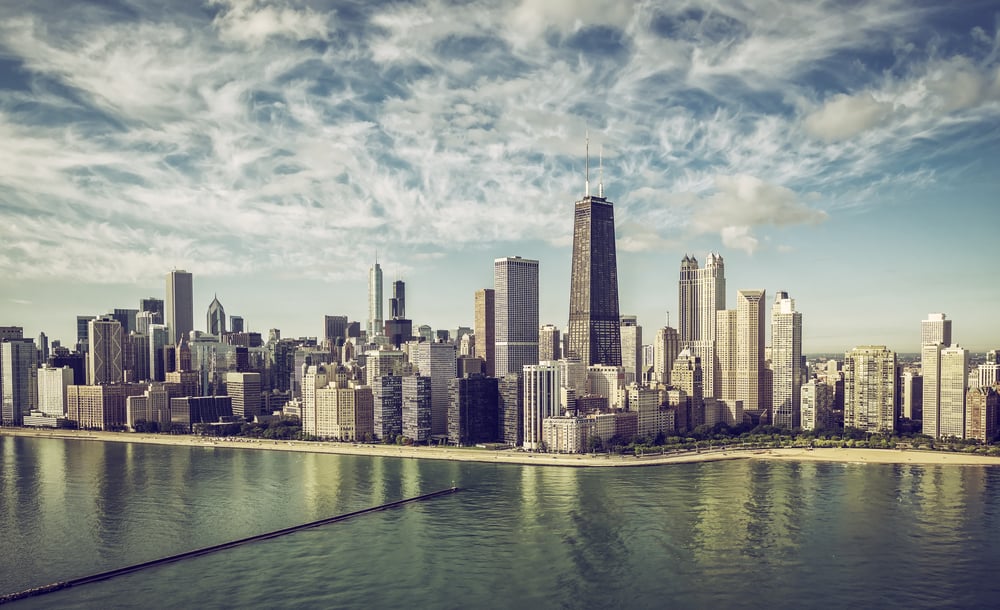The 30 Best Places to Live in Wyoming: Top Cities and Towns

Wyoming offers residents a unique combination of wide-open spaces, outdoor recreation opportunities, and tight-knit communities that attract people seeking an alternative to crowded urban areas.
The state’s low population density means less traffic, lower crime rates in many areas, and a slower pace of life that appeals to families, retirees, and remote workers.
This comprehensive guide examines thirty communities across Wyoming, from small towns like Sundance and Hulett to larger cities such as Cheyenne and Casper, evaluating factors like cost of living, schools, employment opportunities, and recreational amenities.
Each location presents distinct advantages, whether it’s proximity to national parks, affordable housing, strong local economies, or access to world-class outdoor activities like skiing, fishing, and hiking.
Here are the 30 best places to live in Wyoming:
30. Sundance
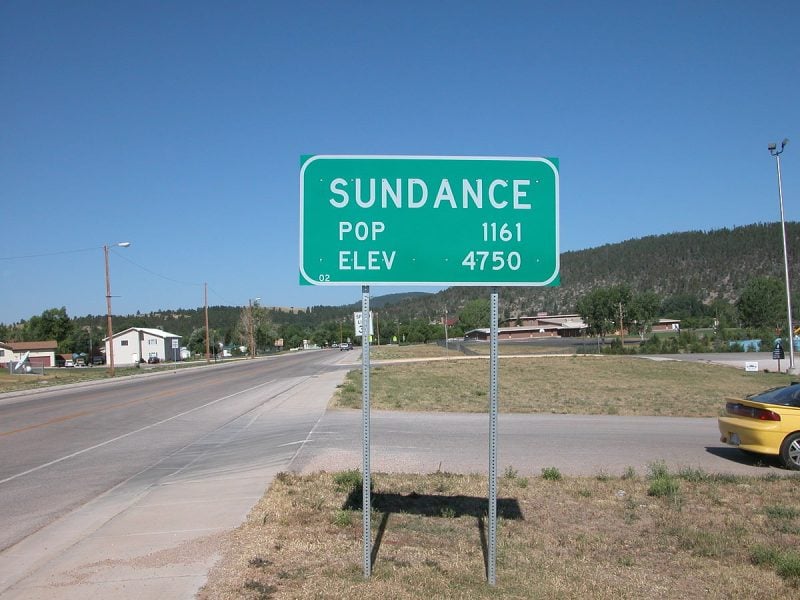
Sundance sits in northern Wyoming with a population of approximately 1,200 residents. This small town has earned recognition as one of the best places to live in the state according to various ranking systems.
The town offers affordable housing compared to Wyoming’s state average of $294,307. Home prices remain below this benchmark, making it accessible for potential residents.
Sundance maintains a poverty rate of 11.8%, which falls 16% lower than the national average. The typical household earns $54,583 annually, though this figure sits below the national median of $67,500.
Rankings consider factors like unemployment rates, education levels, economic health, and quality of life indicators. These metrics contribute to Sundance’s consistent placement among Wyoming’s top communities.
The town provides small-town living with access to northern Wyoming’s natural landscape and outdoor recreational opportunities.
29. Kaycee
Kaycee is a small town with a population of approximately 250 residents. The community sits in Johnson County and offers a rural lifestyle in central Wyoming.
The town receives high rankings across multiple categories. It scores 8.2 out of 10 for overall ranking according to rating systems.
Education stands out as a strength with a 9 out of 10 rating. The amenities score reaches 8.5 out of 10 despite the town’s small size.
Housing costs remain affordable compared to Wyoming averages. Home prices in Kaycee fall below the state average of $294,307.
The cost of living index sits at 96, making it relatively affordable. Crime and safety receive a moderate rating of 6.2 out of 10.
Kaycee provides access to Wyoming’s outdoor recreation opportunities. The town appeals to those seeking a quiet, rural community atmosphere.
28. Hulett
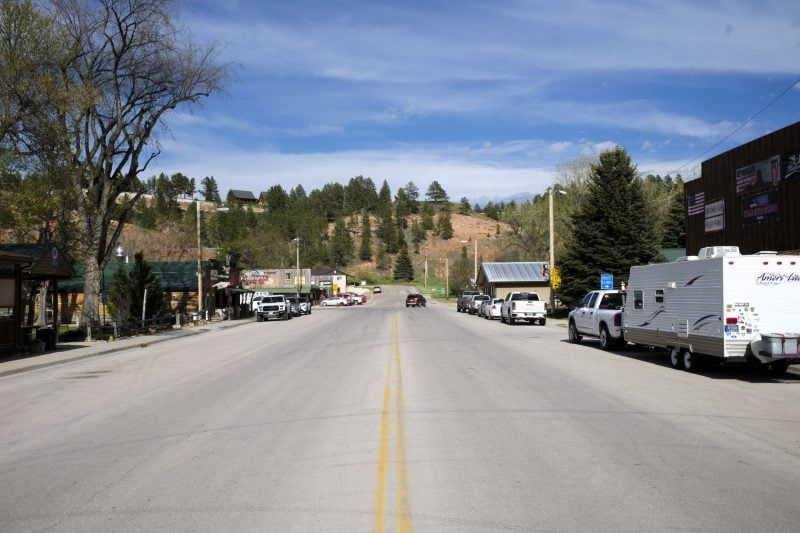
Hulett is a small village in northeastern Wyoming with a population of 403 residents. The community sits in Crook County near the base of Devils Tower National Monument.
The village experiences a hot summer and mild winter climate. This weather pattern makes outdoor activities accessible throughout much of the year.
Housing costs in Hulett remain below Wyoming’s state average of $294,307. The lower real estate prices attract residents seeking affordable mountain living.
Devils Tower’s proximity provides exceptional recreational opportunities. Hiking, rock climbing, and wildlife viewing draw both residents and visitors to the area.
The small population creates a tight-knit community atmosphere. Residents often know their neighbors and participate in local events together.
Hulett’s rural location means limited shopping and dining options within the village. Most residents travel to larger towns for major purchases and services.
27. Ten Sleep
Ten Sleep is a small town nestled in the Bighorn Mountains of northern Wyoming with a population of 214 residents. The community sits in Washakie County and offers a suburban rural atmosphere.
Most residents rent their homes rather than own them. The median home price aligns closely with Wyoming’s state average of $294,307.
The town provides access to outdoor recreation activities including hiking, fishing, and camping in the surrounding mountain terrain. Ten Sleep’s location offers proximity to natural areas and wilderness spaces.
Public schools in Ten Sleep receive high ratings from education evaluators. The community maintains small-town values with a tight-knit resident base.
Political tendencies in Ten Sleep lean conservative, reflecting broader regional patterns. The town’s peaceful setting attracts residents who prefer quieter rural living over urban environments.
Ten Sleep’s mountain location provides scenic views and outdoor lifestyle opportunities for those seeking a remote Wyoming community.
26. Alcova
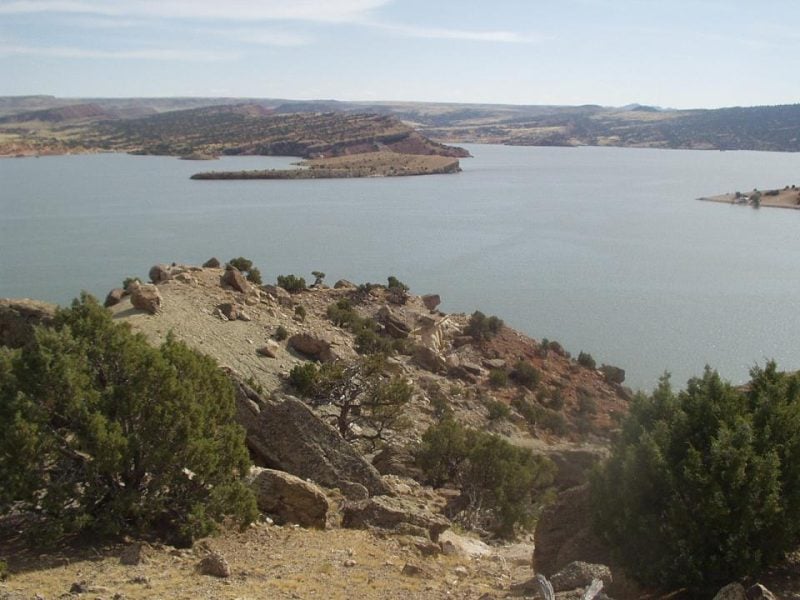
Alcova stands out as a small census-designated place in Wyoming with remarkable livability scores. The community earns a 94 out of 100 rating on quality of life measures.
Families need approximately $57,600 annually to live comfortably in Alcova. Individual residents require around $30,400 per year for a comfortable lifestyle.
Housing costs exceed Wyoming’s state average of $294,307. This price difference reflects the area’s desirability among potential residents.
The community scores well across multiple categories including education levels and crime rates. Weather conditions and cost of living also contribute to its high rankings.
Alcova offers residents an affordable lifestyle despite higher housing costs. The small-town atmosphere provides a peaceful setting for those seeking quality living in Wyoming.
25. Lovell
Lovell is a small agricultural town in northern Wyoming with just over 1,000 residents. The community offers a strong sense of charm and close-knit neighborhood feel that attracts those seeking small-town living.
Home prices in Lovell remain affordable compared to Wyoming’s state average of $294,307. The lower cost of living makes it an attractive option for budget-conscious residents.
The town serves as a rural agricultural hub with a slow-paced, relaxed lifestyle. Residents have access to outdoor recreational activities including lake fishing, camping, and snowmobiling during winter months.
Lovell’s location in northern Wyoming provides opportunities for adventure and outdoor exploration. The small population creates a unique community atmosphere where neighbors know each other well.
The town appeals to those who prefer rural living over urban environments. Its agricultural focus and outdoor recreation options define much of daily life for residents.
24. Basin
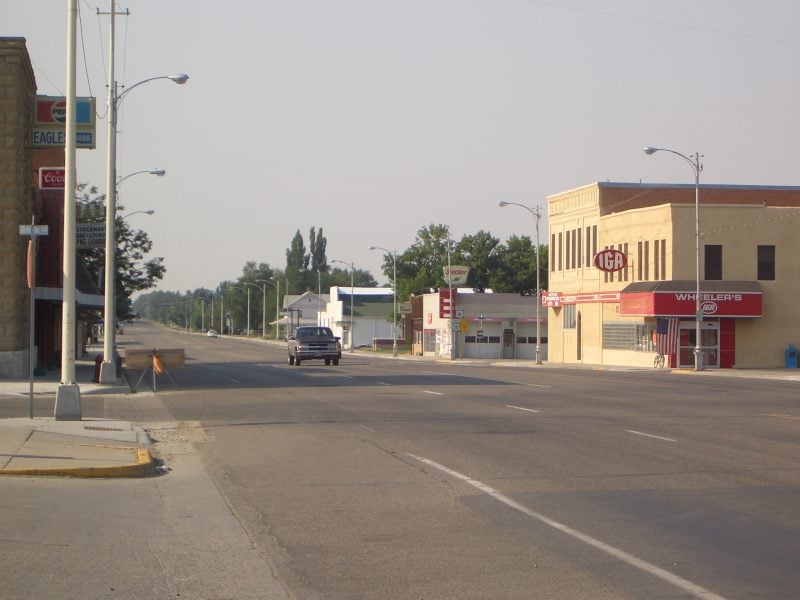
Basin sits in north-central Wyoming near the Bighorn Mountains. The small town offers residents a quiet rural lifestyle with outdoor recreation opportunities nearby.
The community maintains a population of around 1,200 people. Basin provides essential services including schools, medical facilities, and local businesses.
Residents enjoy access to fishing along the Greybull River. The town serves as a gateway to outdoor activities in the surrounding mountain areas.
Housing costs remain affordable compared to larger Wyoming cities. The local economy relies on agriculture, oil, and gas industries.
Basin offers a tight-knit community atmosphere where neighbors know each other. The town hosts annual events that bring residents together throughout the year.
Winter sports enthusiasts can access nearby skiing and snowmobiling areas. Summer activities include hiking, camping, and wildlife viewing in the Bighorn National Forest.
23. Newcastle
Newcastle sits in the west-central foothills of the Black Hills, offering residents access to natural beauty and outdoor recreation. The small town provides a quiet lifestyle about an hour from major Black Hills attractions.
Housing costs remain affordable compared to Wyoming’s average. Home prices fall below the state average of $294,307, making homeownership accessible for many residents.
The community maintains low crime rates and operates quality school systems. These factors contribute to Newcastle’s recognition as a livable small town in Wyoming.
Residents enjoy the scenic mountain foothills setting while maintaining reasonable living expenses. The town appeals to those seeking a peaceful environment with outdoor access.
Newcastle’s location provides both small-town charm and proximity to regional attractions in the Black Hills area.
22. Big Piney

Big Piney sits in Wyoming’s scenic Upper Green River Valley with approximately 1,100 residents. The small town offers a peaceful atmosphere away from urban congestion.
The community provides abundant outdoor recreation opportunities. Residents enjoy access to hiking, fishing, and exploring the surrounding natural landscape.
Home prices in Big Piney exceed Wyoming’s state average of $294,307. The local real estate market reflects demand for properties in this rural setting.
The town faces economic challenges with an unemployment rate of 14.1%. The median household income stands at $58,375, though some reports indicate varying population figures.
Big Piney appeals to those seeking small-town living in a mountain valley environment. The location attracts residents who prioritize outdoor activities and rural tranquility over urban amenities.
21. Kemmerer
Kemmerer sits in southwestern Wyoming with a population of approximately 2,747 residents. The small town maintains a rural character while offering modern amenities including shopping and dining options.
The community reports a poverty rate of 6.3%, which falls significantly below the national average. Median household income reaches $63,000 annually.
Kemmerer Municipal Airport provides convenient access, connecting residents to larger metropolitan areas like Denver within a short flight. This proximity offers employment opportunities while maintaining small-town living.
The town appeals to families seeking low crime rates and quality educational opportunities. Residents enjoy outdoor activities including fishing and hunting in the surrounding area.
Housing costs vary throughout different neighborhoods within Kemmerer. The community offers a mix of rural charm and practical amenities for those preferring smaller population centers in Wyoming.
20. Torrington
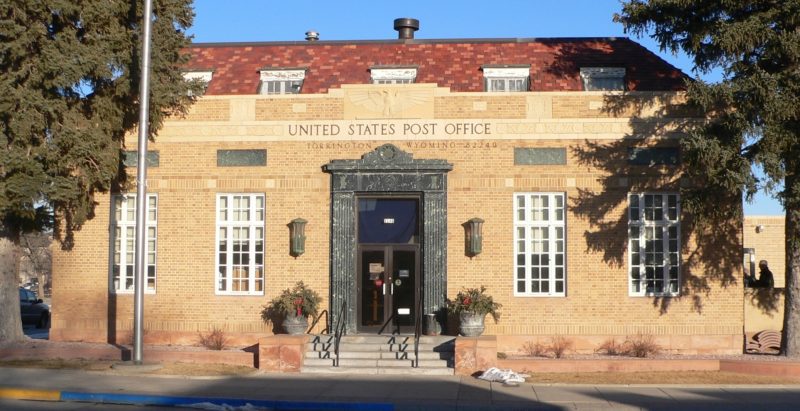
Torrington sits in Goshen County as a small rural community with approximately 3,000 residents. The town ranks 7th among the most diverse places to live in Wyoming.
Housing costs remain affordable compared to state averages. Two-bedroom rentals average $850 monthly, which falls 8.2% below Wyoming’s average rental price.
The community requires a minimum annual income of $38,160 for families and $25,600 for single residents to live comfortably. This makes Torrington accessible for various income levels.
Torrington earned recognition as one of Wyoming’s better places to live based on natural amenities and housing affordability. The town received a livability score of 67 out of 100 from area assessment tools.
The rural setting provides a quieter lifestyle while maintaining essential amenities. Torrington offers a balance between small-town living and practical necessities for residents.
19. Mountain View
Mountain View sits nestled within the Shoshone National Forest in southwestern Wyoming. The town offers residents direct access to extensive outdoor recreation opportunities including camping, fishing, and hiking trails.
The community maintains a small-town atmosphere where local businesses support each other. Residents can find most daily necessities within the town limits.
Housing costs in Mountain View remain affordable compared to many Wyoming communities. The area attracts people seeking a quieter lifestyle surrounded by natural beauty.
The town’s location provides easy access to forest lands and wilderness areas. This makes it appealing for those who prioritize outdoor activities and nature-based recreation.
Mountain View’s tight-knit community creates a strong sense of belonging among residents. The town combines rural living with access to essential services and amenities.
18. Rawlins
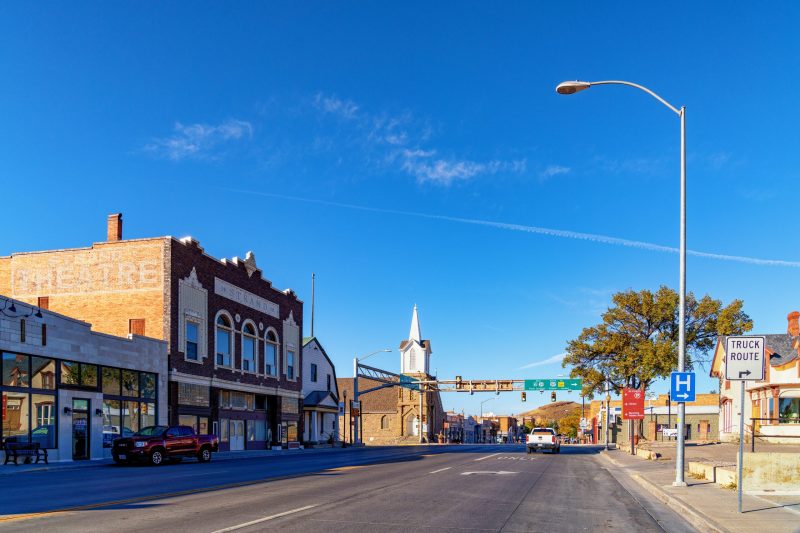
Rawlins sits in south-central Wyoming with a population of approximately 8,700 residents. The city serves as the county seat of Carbon County and maintains a small-town atmosphere.
The median household income reaches $70,255, which exceeds the national average. The poverty rate stands at 12.3%, falling below the national figure.
Rawlins benefits from its location amid Wyoming’s landscape, providing mountain views and outdoor recreation opportunities. The city maintains a stable economy supported by various industries.
Housing costs remain reasonable compared to larger metropolitan areas. The community offers basic amenities and services typical of small Wyoming towns.
Rawlins ranks 36th among Wyoming cities for livability. The area experiences the state’s characteristic continental climate with cold winters and mild summers.
The city provides access to outdoor activities including hiking, fishing, and hunting in the surrounding region.
17. Pinedale
Pinedale sits in the Wind River Range of the Rocky Mountains with a population just over 2,000 residents. The small town combines scenic mountain views with a tight-knit community atmosphere.
The town scores well for safety and affordability, receiving ratings of 8 out of 10 in both categories. Residents benefit from a median household income of approximately $86,550, which exceeds the national median.
Pinedale offers numerous outdoor recreation opportunities throughout the year. The surrounding Wind River Range and Wyoming Range provide access to hiking, fishing, and winter sports activities.
The community attracts those who appreciate a slower pace of life compared to larger cities. However, residents must be prepared for harsh winters that are characteristic of this mountain location.
Housing quality varies significantly across different neighborhoods within the town. The area maintains its character through a mix of longtime residents and industrial workers.
16. Thermopolis
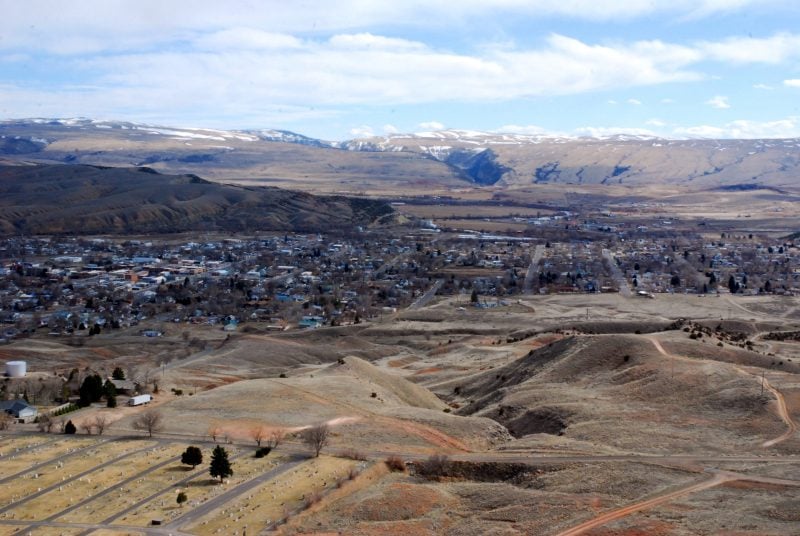
Thermopolis sits in Hot Springs County in northwestern Wyoming. The small town attracts visitors from across the region with its natural hot springs and mineral water attractions.
According to BestPlaces, Thermopolis earned an overall livability score of 6.9 out of 10. This ranking places it among Wyoming’s more desirable communities for residents.
Housing costs remain below the state average in Thermopolis. The typical home price falls under Wyoming’s average of $294,307, making homeownership more accessible for many buyers.
The town’s compact size creates a tight-knit community atmosphere. Residents benefit from lower living expenses compared to larger Wyoming cities while maintaining access to the area’s natural attractions.
Thermopolis offers outdoor recreation opportunities alongside its famous hot springs. The combination of affordable housing and natural amenities makes it appealing to those seeking small-town living in Wyoming.
15. Worland
Worland sits in the Big Horn Basin with a population of approximately 4,000 residents. The city offers majestic mountain views and a rural atmosphere with abundant open spaces.
The town center features coffee shops, restaurants, stores, and a public library. Local amenities provide residents with essential services and community gathering spots.
Worland maintains an almost nonexistent crime rate, contributing to its safe living environment. The median income reaches $49,191, providing residents with decent economic stability.
The school system receives positive ratings from locals and education evaluators. Families appreciate the quality educational opportunities available to their children.
Outdoor recreation opportunities abound throughout the area. Residents access hiking trails, fishing spots, and cycling routes in the surrounding landscape.
The peaceful atmosphere attracts people seeking a wholesome small-town lifestyle. Housing costs remain affordable compared to many other Wyoming communities.
14. Douglas
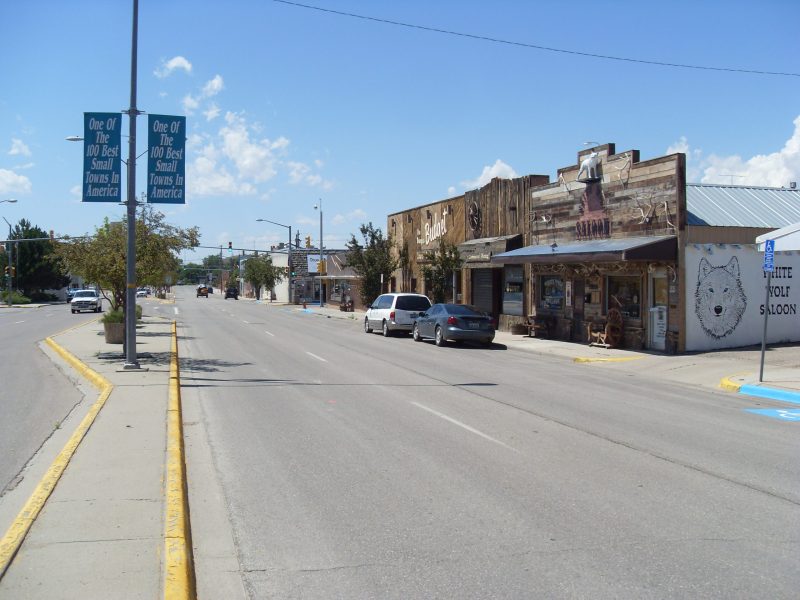
Douglas stands as a small Wyoming community with approximately 6,369 residents. The town maintains a consistent reputation among Wyoming’s better places to live.
The median household income reaches $68,923, slightly exceeding the national average of $67,500. Douglas demonstrates economic stability with a poverty rate of 10.1%, which sits 28% below the national average.
Housing costs remain affordable compared to state averages. Home prices in Douglas fall below Wyoming’s average of $294,307, making homeownership accessible for residents.
Douglas earned a livability score of 71 out of 100 from AreaVibes. The town ranks 23rd within Wyoming for overall quality of life factors.
The community offers solid job opportunities despite its smaller size. Residents benefit from lower crime rates and reasonable cost of living compared to larger cities.
13. Green River
Green River sits in southwest Wyoming with a population of 11,679 residents. The city offers a sparse suburban feel where most residents own their homes.
The median household income reaches $72,656, providing solid economic stability. Average home prices stay affordable at around $197,900, making homeownership accessible compared to many areas.
Mining and energy serve as the primary industries driving the local economy. The location provides easy access to outdoor recreation with numerous fishing, hunting, and hiking opportunities nearby.
Families and young professionals make up much of the population. The community features numerous parks and recreational facilities for residents to enjoy.
Public schools in Green River perform above average levels. The high desert landscape and Rocky Mountain setting create an appealing environment for those seeking small-town living with natural beauty.
12. Buffalo
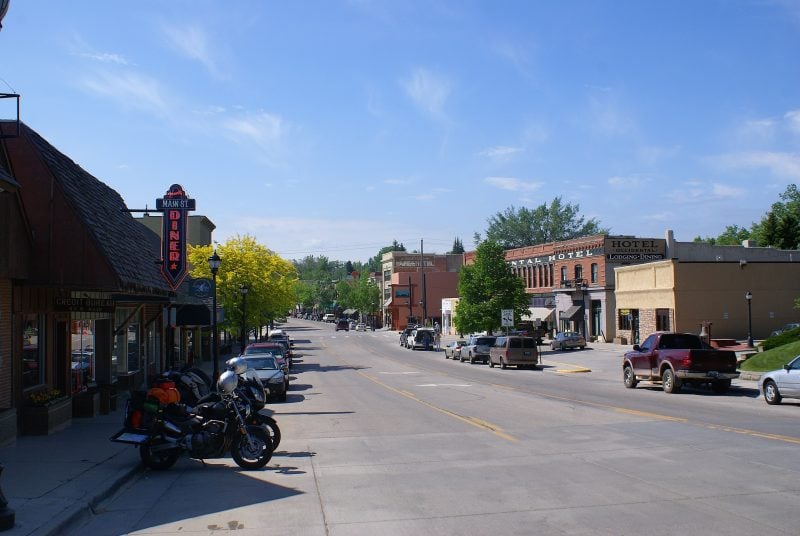
Buffalo sits in Johnson County with a population of approximately 4,500 residents. The town offers a sparse suburban feel where most residents own their homes.
The community provides access to outdoor activities near the Bighorn Mountains. Downtown Buffalo features diverse shops, restaurants, and entertainment options.
Buffalo maintains above-average public schools, making it suitable for families. The area attracts many retirees and tends to have a conservative population.
Housing costs remain below Wyoming’s state average of $294,307. The typical household earns $58,679 annually, which falls below the national median.
The poverty rate stands at 15.4%, approximately 10% higher than the national average. Buffalo combines small-town atmosphere with proximity to natural recreation opportunities.
11. Lander
Lander sits in central Wyoming’s Fremont County with a population of 7,487 residents. The small town offers affordable living with a poverty rate of 9.3%, significantly lower than the national average.
The typical household earns $57,938 annually, which falls below the national median. However, the lower cost of living helps offset this difference for residents.
Lander ranks well in several categories for Wyoming towns. It places 11th out of 25 for employment opportunities and 13th for weather conditions across the state.
The town serves as a gateway to outdoor recreation opportunities. Its location provides access to the Wind River Range and numerous wilderness areas.
Housing quality varies throughout Lander’s neighborhoods. The real estate market reflects this disparity with different home values across various areas of the town.
10. Evanston
Evanston sits in Uinta County with a population of approximately 11,727 residents. The city offers breathtaking mountain views and serves as a hub for outdoor enthusiasts.
Hiking, fishing, and hunting opportunities abound in the surrounding area. The scenic landscape attracts visitors and residents who enjoy recreational activities.
The typical household earns $62,356 annually, which falls slightly below the national median. However, the poverty rate stands at 12.9%, which is 8% lower than the national average.
Evanston provides essential amenities including shopping centers, restaurants, and entertainment venues. The city maintains easy access to major highways for convenient travel.
The community demonstrates strong local spirit and offers various business opportunities. Housing quality varies significantly across different neighborhoods within the city.
Evanston has earned recognition as one of Wyoming’s better places to live, particularly appealing to those seeking outdoor recreation and small-town atmosphere.
9. Gillette
Gillette stands as Wyoming’s energy capital in the northeastern region. The city built its foundation on coal mining in the late 1800s and continues to drive the state’s economy today.
The community of 32,513 residents enjoys financial stability with median household earnings of $73,867. This exceeds the national average by over $6,000 annually.
Housing costs remain reasonable compared to many Western cities. Gillette ranks 10th out of 31 Wyoming locations for home buying opportunities.
The poverty rate sits at 12.9%, which is 8% below the national average. This reflects the area’s strong job market and economic opportunities.
Neighborhoods vary significantly in quality and home values throughout the city. The energy sector provides steady employment but creates some economic dependence on industry fluctuations.
Residents experience a blend of small-town community feel with urban amenities and services.
8. Casper
Casper stands out as Wyoming’s second-largest city, offering residents a balanced mix of urban conveniences and outdoor recreation. The city serves as a regional hub with diverse employment opportunities in energy, healthcare, and business sectors.
Housing costs remain reasonable compared to national averages. The real estate market features neighborhoods with varying price points and character throughout the city.
Outdoor enthusiasts benefit from Casper’s central location and proximity to hiking trails, fishing spots, and recreational areas. The city maintains several parks and facilities for year-round activities.
Casper provides essential amenities including shopping centers, restaurants, and cultural attractions. The community supports local events and maintains a welcoming atmosphere for new residents.
The city’s infrastructure includes quality schools and healthcare facilities. Transportation access connects Casper to other Wyoming cities and regional destinations efficiently.
7. Riverton
Riverton sits in central Wyoming with a rich history rooted in Native American heritage from the Shoshone and Arapaho tribes. The city offers excellent affordability with goods and services costing 13.5% less than the national average.
The community earned recognition as the 37th best place to live in America according to recent rankings. Riverton receives a livability score of 74 out of 100 from BestPlaces, reflecting strong performance across multiple quality of life factors.
Housing costs remain reasonable compared to many areas. The city provides good employment opportunities and maintains relatively low crime rates in desirable neighborhoods.
Riverton ranks 63rd out of communities within Wyoming. The area attracts residents seeking affordable living without sacrificing essential amenities and services.
6. Rock Springs
Rock Springs stands out as one of Wyoming’s most livable cities, consistently ranking among the state’s top destinations. The city sits in Sweetwater County and offers residents a strong business community alongside excellent quality of life.
Cultural attractions include the Sweetwater County Historical Museum, perfect for exploring local heritage. The nearby White Mountain Petroglyphs provide additional historical interest with regular events and exhibits.
Housing quality varies significantly throughout Rock Springs neighborhoods. The best areas typically feature higher median home values and reflect strong market demand from residents seeking quality living environments.
Rock Springs made Livability.com’s top 10 list of best Wyoming places to live. The city attracts people through its combination of economic opportunities and community amenities, making it an attractive option for families and professionals.
5. Cody
Cody recently claimed the top spot as Wyoming’s best place to live. This historic western town serves as the eastern gateway to Yellowstone National Park.
The city combines Old West charm with modern amenities. Central streets feature authentic storefronts and saloons dating back to the frontier era.
Cody offers impressive employment opportunities with low unemployment rates and high median incomes. The town provides access to world-class outdoor recreation along the Chief Joseph Scenic Byway.
Residents enjoy the famous Buffalo Bill Center of the West Museum and regular rodeo events. The community maintains wide open spaces with mountain views visible from most neighborhoods.
Housing quality varies significantly throughout different areas of town. The best neighborhoods command higher home values but offer superior amenities and lower crime rates.
4. Sheridan
Sheridan sits in northern Wyoming near the Bighorn Mountains. The city ranks first in the state for cost of living and housing affordability.
Home prices in Sheridan exceed the Wyoming state average of $294,307. Despite higher housing costs, residents benefit from overall affordable living expenses.
The Bighorn Mountains provide extensive outdoor recreation opportunities. Hiking, skiing, and camping attract residents who enjoy mountain activities.
Sheridan maintains a close-knit community atmosphere typical of smaller Wyoming cities. The downtown area preserves its historic character while offering modern amenities.
The city ranks fourth among Wyoming’s best places to live according to recent rankings. Strong local schools and low crime rates contribute to its appeal.
Sheridan balances small-town living with access to outdoor adventures. The combination of mountain proximity and community feel makes it attractive to families and retirees.
3. Laramie
Laramie stands as one of Wyoming’s most attractive cities for residents seeking a balance of natural beauty and urban amenities. The city sits in southeastern Wyoming along the Laramie River with a population of approximately 31,848 people.
Home to the University of Wyoming, Laramie offers a vibrant college town atmosphere. The university brings cultural activities, educational opportunities, and a youthful energy to the community.
The city provides easy access to Medicine Bow National Forest, offering residents outdoor recreation opportunities including hiking, fishing, and camping. Mountain views and wide open spaces define the local landscape.
Downtown Laramie features numerous shops, restaurants, bars, and cafes that serve local cuisine. The area maintains a dense suburban feel with many residents choosing to rent their homes.
Laramie ranks in the 77th percentile of all American cities for livability, earning recognition as the sixth best city in Wyoming for safety and college readiness.
2. Jackson
Jackson ranks as the 8th best city to live in Wyoming according to BestPlaces.net. This small mountain town sits in Teton County in northwestern Wyoming.
The city earned an overall livability score of 75. Jackson offers residents economic stability and low crime rates.
Beautiful mountain surroundings define the area’s natural appeal. The town provides plenty of job opportunities for residents.
Jackson’s proximity to the mountains makes it attractive for outdoor enthusiasts. The location offers access to recreational activities year-round.
The town maintains a balance between small-town charm and economic opportunity. Housing quality varies significantly throughout different neighborhoods in Jackson.
Real estate values reflect the desirable mountain location. The market considers Jackson’s neighborhoods among the most sought-after areas in the region.
Jackson combines natural beauty with practical amenities. The town serves residents who value both outdoor access and community stability.
1. Cheyenne
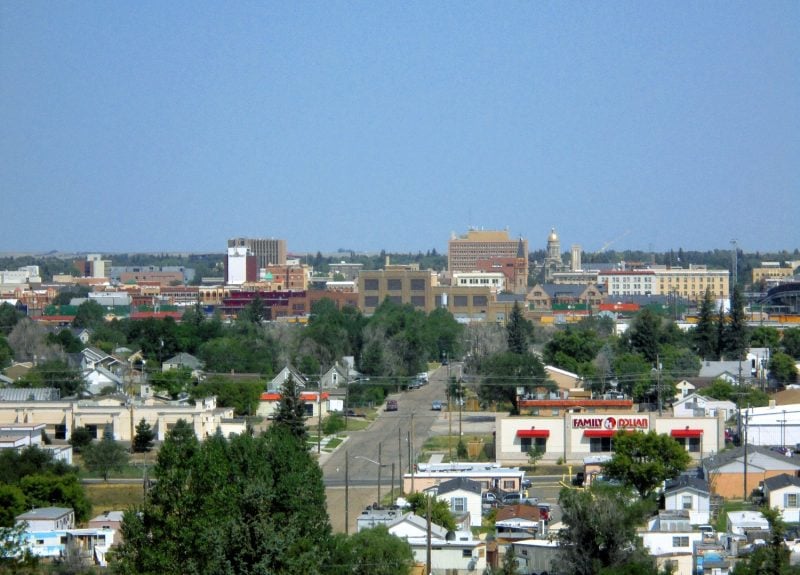
Cheyenne serves as Wyoming’s capital and largest city. The city combines Western heritage with modern amenities, making it attractive to families and professionals.
Fortune.com has ranked Cheyenne among its 50 Best Places to Live for Families for two consecutive years. The city receives an A+ rating for amenities including entertainment, education, and recreational activities.
Cheyenne offers strong job market conditions and reasonable cost of living. Crime rates remain low, contributing to the city’s reputation as a safe place to live.
Several neighborhoods stand out for their quality. The Avenues features historic homes and tree-lined streets. Saddle Ridge provides family-friendly amenities with mountain views.
South Fork offers diverse housing options near parks and shopping centers. Western Hills provides quiet suburban living for residents seeking tranquility.
Key Factors Shaping Quality of Life in Wyoming
Wyoming’s appeal stems from its low cost of living, strong educational systems, and tight-knit communities that offer residents both financial advantages and meaningful social connections. These elements combine with the state’s natural beauty to create living conditions that rank Wyoming among the top states nationally.
Cost of Living Considerations
Wyoming offers significant financial advantages compared to most U.S. states. The state has no personal income tax, which allows residents to keep more of their earnings.
Housing costs remain affordable across most Wyoming communities. Properties in smaller towns like Powell average around $179,000 for purchase, while rental homes typically cost $650 monthly.
Energy costs stay low due to Wyoming’s abundant natural resources. The state produces coal, oil, and natural gas, keeping utility bills manageable for residents.
Property taxes remain reasonable throughout the state. This creates additional savings for homeowners compared to higher-tax states.
Sales taxes vary by municipality but generally stay below national averages. Combined with no state income tax, this creates substantial overall tax savings for Wyoming residents.
Access to Education and Healthcare
Wyoming maintains strong educational systems with smaller class sizes than national averages. Rural communities often feature well-funded schools that provide personalized attention to students.
The University of Wyoming serves as the state’s flagship institution. It offers comprehensive programs while maintaining affordable tuition rates for residents.
Community colleges throughout Wyoming provide vocational training and transfer opportunities. These institutions support both traditional students and working adults seeking career advancement.
Healthcare access varies significantly between urban and rural areas. Larger cities like Cheyenne and Casper offer full medical facilities and specialist services.
Rural healthcare relies heavily on critical access hospitals and telemedicine. Distance to specialized care can present challenges for residents in remote areas.
Community and Lifestyle
Wyoming communities emphasize outdoor recreation and neighbor-to-neighbor connections. Residents frequently participate in hunting, fishing, hiking, and winter sports activities.
Small-town environments foster strong social bonds. Many communities organize festivals, rodeos, and seasonal celebrations that bring residents together.
Low crime rates contribute to feelings of safety and security. Families often feel comfortable allowing children greater independence than in urban environments.
Cultural activities vary by community size. Larger towns offer theaters, museums, and arts programs, while smaller communities focus on local traditions and outdoor pursuits.
The pace of life tends toward relaxation and work-life balance. Many residents choose Wyoming specifically to escape urban stress and embrace simpler living.
Trends Impacting Residential Choices
Wyoming’s residential landscape is shaped by significant employment shifts toward energy and technology sectors, alongside growing demand for outdoor recreation access. These factors drive housing decisions as residents prioritize career opportunities and lifestyle amenities.
Workforce and Employment Opportunities
Wyoming’s economy continues evolving beyond traditional coal mining toward renewable energy, technology, and healthcare sectors. Cities like Cheyenne and Casper attract workers through government positions and emerging tech companies.
The state’s low unemployment rate creates competitive advantages for job seekers. Energy companies in areas like Gillette are transitioning to wind and solar projects, retaining skilled workers while attracting new talent.
Remote work flexibility has increased demand for smaller Wyoming communities. Towns like Jackson and Laramie benefit from professionals seeking lower costs while maintaining career advancement opportunities.
Healthcare expansion drives residential choices in regional centers. Sheridan and Rock Springs experience growth as medical facilities expand services, creating employment clusters that influence housing patterns.
Outdoor Recreation and Natural Attractions
Proximity to Yellowstone and Grand Teton National Parks significantly impacts housing demand in northwestern Wyoming. Towns like Cody and Pinedale see increased interest from outdoor enthusiasts and seasonal residents.
Winter recreation drives choices in mountain communities. Areas near ski resorts experience year-round population growth as residents prioritize access to skiing and snowboarding.
Fishing and hunting access influences rural residential patterns. Communities along prime fishing rivers like the North Platte attract residents seeking outdoor lifestyles.
Trail systems and recreational infrastructure development in cities like Casper and Laramie appeal to families prioritizing active lifestyles. These amenities become deciding factors for relocating professionals.
